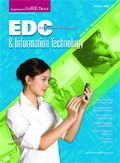Tackling Allergy Studies with an e Diary
How this electronic data capture technology enhanced clinical trial design for two allergy studies.
There are approximately 55 million allergy sufferers in the United States, and only 5% of them are currently being treated with subcutaneous injection immunotherapy (i.e., allergy shots). Despite the myriad of prescription and OTC medications available to relieve symptoms, the only immunotherapy to prevent and reduce future allergy responses available in the United States is administered via injection.

Photography: Getty Images
People who refuse immunotherapy are often reluctant to undergo needle intensive treatments or do not have the time for the continual physician office visits required. Therefore, the vast majority of allergy sufferers rely on anti-allergy medications, which may help to minimize symptoms but do not address the cause.
Potential alternative
Greer Laboratories of Lenoir, NC, was founded in 1904 and provides allergy immunotherapy products and services for the treatment of humans and animals. Today, Greer is investigating the use of sublingual immunotherapy as an alternative route of administration to current injection immunotherapy.
Sublingual immunotherapy, which is not yet approved by FDA for use in the United States, treats the root cause by dispensing drops of an allergen solution under the tongue. The solution works with the body's immune system to decrease allergic sensitivity over time. With sublingual immunotherapy no shots are required and subjects may self-administer at home instead of going to a doctor's office. Sublingual immunotherapy has been used successfully in Europe for many years, and Greer hopes to offer allergists in the United States this alternative for treating allergies.
Paper vs electronic
Greer's commitment to providing an effective alternative for allergy immunotherapy extends into its trial design. Greer is using cutting edge electronic patient reported outcome (ePRO) solutions from PHT Corporation of Boston instead of paper diaries in its clinical research programs. "PHT stood out among ePRO vendors because of its excellent service," said Brad Whitlow, Greer's clinical project manager for the trials. "The PHT team came up with innovative ideas for optimizing diary designs to ensure our primary endpoint data were captured in a way that was simple for subjects."
PHT's LogPad System captures ePRO data on mobile handheld devices. Data are transmitted daily from subjects' homes throughout the United States to a central server hosted by PHT. There, the data is accessed by site personnel, monitors, and sponsors in real time in order to manage subject symptoms and compliance. The LogPad System helps Greer improve data quality, enhance safety, and conduct more efficient clinical studies for this exciting investigational therapy.
Real-time results
"One of Greer's primary concerns is for the safety of subjects enrolled in the trials," said Whitlow. "Sites in the studies are able to monitor allergy symptoms and medication use with an online portal, PHT StudyWorks. Once data is entered by the subjects, the sites know immediately what symptoms the subjects are experiencing and are able to make the appropriate adjustments if necessary. This level of firsthand knowledge and response is only possible using a real-time ePRO solution."
One of the sites Greer is using to conduct the allergen studies is the well-known research arm of the Family Allergy and Asthma Institute in Louisville, KY. Patti Hall, RN, CCRC, director of clinical research at Family Allergy, explained, "The major difference in using an eDiary instead of paper is a huge increase in the percentage of patient compliance, which also increases patient safety. We can track every patient and get results from their eDiaries in real time."
According to Hall, the immediate information they receive as a subject completes a questionnaire enables her team of nine coordinators and investigators to know in real time if a subject is being compliant and answering the questionnaire. "It gives us the opportunity to keep an eye on patient safety and also to make sure they complete every question and enter data correctly," she said. "The questionnaire is designed so the patient has to answer each question appropriately before proceeding to the next one."
Louisville is an ideal site for the Greer study. "We're in the Ohio Valley, which is one of the top three ragweed areas in the country," noted Hall. "Our state flower is the goldenrod, so that gives you an idea of the prevalence of ragweed. It's an enormous problem from mid-August until the first hard frost. We have more than 13,000 patients in our research database, and often our patients will call and ask if they can be part of a new study before they start taking their medication."
Enhancing trial design
Greer has used the LogPad in Phases I and II sublingual immunotherapy safety and dosing trials for seasonal ragweed and timothy grass allergies, and continues to use the LogPad in the Phase III pivotal trial. The treatment group underwent sublingual immunotherapy eight weeks prior to the allergen season and continued until the completion of the pollen season. Throughout the trial Greer asked questions about rhino conjunctivitis symptoms such as watery eyes and a runny nose, which are typical of many allergy sufferers.
For each study, Greer used the LogPad to assign subjects to their correct dose level. A subject was dosed and at the end of 15 minutes recorded his or her symptoms in the LogPad. The site coordinator reviewed the symptoms and increased the dose until the subject recorded a moderate symptom level. This was considered the maximum tolerable dose and was the dose the subject took at home.
"We train each patient as he or she comes in for the initial screening," Hall said. "We show the patient how to use the LogPad and we have them make their first entry here at the site to make sure they know how to use it." Subjects then began self-administering the therapy at home every day and continued to enter symptom information in the LogPad. Study coordinators monitored these symptoms regularly and if a subject's symptoms changed such that a dose modification was required, the subject would be notified to visit the site.
Subject satisfaction
Whitlow said that subjects enjoyed using the LogPad to enter and transmit data. "They acclimate to it because it's a novel technology. There is a bit of a 'gadget factor' to a LogPad, even among older subjects, which makes them excited about using it." He added that including college age subjects introduced some challenges. For example, Greer had to deploy more wireless devices and use cellular data transmission because a lot of those subjects did not have landline telephones.
The benefits of the LogPad went beyond just the "wow" factor. The LogPad made responding easier by reducing burden. Diaries were only available during appropriate times as specified by the protocol, thus eliminating unplanned recall bias and invented data. The LogPad triggered audible alarms in the morning and evening to remind subjects to take the study medication or to complete a diary and timestamped all data to verify appropriate responses. "PHT's technology allowed me to take the trial design beyond any I could have done otherwise," noted Whitlow. "For example, we were able to deploy identical protocols for timothy grass and ragweed studies on the same LogPad device. Sites simply select[ed] the allergen using a pull down menu, and the eDiary branched to provide the appropriate question structure. This reduced purchasing costs, programming expenses, and inventory management while also improving consistency and enhancing visibility."
Greer entered Phase III of the program in March 2008 and again chose PHT to provide the data capture and management mechanisms for the pivotal trial underway at more than 30 sites, which plans to enroll over 400 subjects. By beginning in early spring, Greer can enroll and dose subjects so that they take the study drug at home daily for 12 to 16 weeks before ragweed season, which starts in August. Subjects will continue taking medication through ragweed season, which ends in early October.
Sheila Rocchio is vice president of marketing for PHT Corporation, 500 Rutherford Avenue, Charlestown, MA 02129, email: srocchio@phtcorp.com
SCOPE Summit 2025: Enhancing the Patient Experience Through Site Centricity
February 12th 2025In an interview with ACT senior editor Andy Studna at SCOPE Summit, Ashley Davidson, vice president, product lead - sponsor tech strategy, Advarra, highlights the need for more site-centric approaches in study startup.
